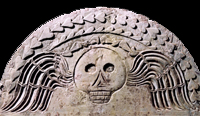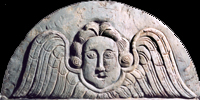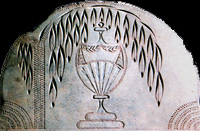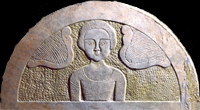RELEVANCE FOR OUR UNDERSTANDING
OF EARLY AMERICA

Gravestones & American Material Culture:
Like other artifacts that have survived from early America, gravestones both embody the sensibilities of the culture in which they were produced and reflect the changing circumstances of the crafts and businesses that produced them. Unlike transportable items such as furniture, pottery, metalware and textiles, gravestones are anchored to their original locales and so can be linked, if not to the specific buyer, then at least to a close family relation of the buyer. We are thus able to determine their exact markets. But unlike architectural structures, which are similarly anchored, gravestones from this early time have survived in greater numbers and without alteration.

The Emergence of the Modern:
Because of the chronological scope of this study, it was possible to consider the development of design elements (decorations and inscriptions) and materials (slate to marble) as representative of the changes in American society and culture associated with the emergence of the “modern.” Nathaniel Holmes, for example, the most productive stonecutter of this study, carved gravestones through a seventy-year career from 1799 through 1869--from the aftermath of the Revolution through the Civil War: His more than 1400 surviving gravestones provide a fascinating look into the evolving tastes and preferences of the time. Or consider Josiah Sturgis, who in the 1840s tried to make stonecutting into a genuine business enterprise, with a network of marble “stations” in five Cape Cod towns as well as on Nantucket and Martha’s Vineyard. He failed, joining the rush to California in 1849, where he built and operated a successful hotel until the 1890s.

From Craft to Business Enterprise:
Beyond the value of this study for art history, historians interested in economic and technological development will appreciate the value of the evidence uncovered for the passage from the early craft-apprentice system to more centralized and competitive businesses. There came a time in the 1840s, for example, when the name inscribed at the bottom of a gravestone was not that of the carver or master of the shop, as would have been true earlier, but that of the owner, who may not have participated materially in the physical operation of the shop. Businessmen thus came to replace craftsmen as the directing force of the trade.

�����������������������������������������������������������������



